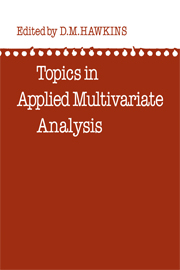Book contents
- Frontmatter
- PREFACE
- CONTRIBUTORS
- Contents
- CHAPTER 1 DISCRIMINANT ANALYSIS
- CHAPTER 2 COVARIANCE STRUCTURES
- CHAPTER 3 THE LOG-LINEAR MODEL AND ITS APPLICATION TO MULTIWAY CONTINGENCY TABLES
- CHAPTER 4 SCALING A DATA MATRIX IN A LOW-DIMENSIONAL EUCLIDEAN SPACE
- CHAPTER 5 AUTOMATIC INTERACTION DETECTION
- CHAPTER 6 CLUSTER ANALYSIS
- INDEX
CHAPTER 3 - THE LOG-LINEAR MODEL AND ITS APPLICATION TO MULTIWAY CONTINGENCY TABLES
Published online by Cambridge University Press: 05 November 2011
- Frontmatter
- PREFACE
- CONTRIBUTORS
- Contents
- CHAPTER 1 DISCRIMINANT ANALYSIS
- CHAPTER 2 COVARIANCE STRUCTURES
- CHAPTER 3 THE LOG-LINEAR MODEL AND ITS APPLICATION TO MULTIWAY CONTINGENCY TABLES
- CHAPTER 4 SCALING A DATA MATRIX IN A LOW-DIMENSIONAL EUCLIDEAN SPACE
- CHAPTER 5 AUTOMATIC INTERACTION DETECTION
- CHAPTER 6 CLUSTER ANALYSIS
- INDEX
Summary
INTRODUCTION
Categorical variables can be divided into two main sub-classes:-nominal and ordinal. Ordinal variables, such as social status, number of children, categorized continuous variables, etc. have some sort of inherent grading which allows one to say, for example, that social class II is on the same “side” of social class I as is social class III, but is “nearer” to it than is social class III. Nominal variables, on the other hand do not have this inherent grading. They are typified by eyecolour, the type of disorder diagnosed in a psychiatric patient, and the city in which one resides.
The binomial, multinomial and Poisson distributions are commonly used for modelling the frequency of occurrence of a particular value of both nominal and ordinal variables.
All three distributions belong to the broader class of the exponential family. This family has the unifying property that the logarithms of the frequencies of occurrence of a particular value of the variable may be expressed as a linear function of the parameters of the distribution. Such models for log frequencies are termed loglinear models. They may be used for the analysis of two-way or multi-way contingency tables and data on rates and proportions (both of which arise naturally with nominal variables), and may also be extended to logit analysis and log-odds ratios which are the natural tools for dealing with ordinal variables.
- Type
- Chapter
- Information
- Topics in Applied Multivariate Analysis , pp. 142 - 182Publisher: Cambridge University PressPrint publication year: 1982
- 3
- Cited by



